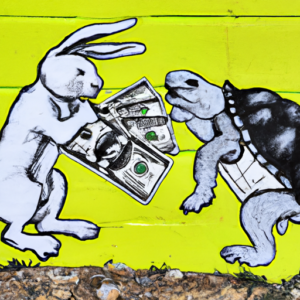The Sexy Tortoise

[Editor’s Note: Below is the full text of Part I of our 238th Weekly Transmission, originally delivered direct to the inbox of more than 600 GEM Diamond members on January 4th, 2023.]
It’s 2023, and founders need to be ready to answer a question seemingly nobody has cared about since 2009: “How quickly can your company become profitable?”
From 2009 to 2022, the world was awash with historically cheap capital searching for yield due to the zero interest rate policy (ZIRP) the Fed implemented to combat the Great Recession. High-growth companies like Uber, Lyft, WeWork, Snap, Airbnb, and Twitter that largely defined the last decade and a half of startup successes delivered those yields to institutional investors by creating category-killing companies that both improved customer experience and took market share at all costs.
For these winners, profitability was a proverbial can kicked down the road. All that mattered was growing revenues aggressively by taking market share from traditional companies in the massive market of your choosing: transportation, office, dating, travel, hospitality, news, blogging, anything-delivery, real estate. The cheap fuel of venture capital was ubiquitous and startups were implored to put on blinders and grow at any cost. Those who built growth engines capable of meeting aggressive milestones were fed additional fuel, which kept the growth engine firing on all cylinders.

The prevailing belief: once these companies had dominated their respective markets, an eventual transition from cash-guzzling market disruptor to dividend paying blue chip would figure itself out. The next Apples, Microsofts, Googles, Amazons, Intels, Salesforces, and … you get the idea … would take their places as the next generation of market leaders. This was Silicon Valley’s circle of life, and these feisty, hard-charging startups were its Simbas.
As per the playbook, the disruptors changed the way many of us lived our day-to-day lives (when’s the last time you hailed a taxi outside NYC?), but the companies and investors enabling those transformations did so mostly ignoring Warren Buffet’s two rules of investing. Rule No. 1: Never lose money; Rule No. 2: Never forget rule No. 1.
When late-stage funding rounds made way for S-1s, it was revealed that many of these mega growth companies were not just losing money, they were doing so like red comma generation was an Olympic event and the only chance of making the podium was pulling a hat trick.
It didn’t matter. The companies went public anyway, and the markets continued to finance their growth. Between 2018-2021 hundreds of SPACs formed to take more money-losing companies public. It seemed the capital markets merry-go-round only had one button on its control panel: faster. By January 2022, prices for both private and public growth companies in the tech sector hit an all time high.
In the same year (albeit a parallel universe), Jerome Powell and the Fed began raising interest rates to combat runaway inflation, at first to no avail. Inflation remained stubborn. So the Fed stayed the course and raised rates again. And again. And again. Gradually, then suddenly, the flow of cheap capital stopped. By late 2022, capital-intensive, unprofitable technology companies shed between half to 95% of their value. Retail and institutional investors alike got burned. Contagion spread to the entire sector; even tech bellwethers like Apple and Microsoft took a nearly 30% haircut.
LOOKING AHEAD
What is a startup or an investor left to learn? It’s absurd to reason that optimizing for strong growth is bad—truly, any company with a product that creates value for customers should grow. But the Fed will continue to grind the gears of economic growth, and the cheap capital financing meteoric startup growth for companies without a plausible path to profitability has dried up faster than the Los Angeles River. The age of cheap growth is a bygone age; growth in 2023 and beyond will be earned, not bought.
Imagine startups are race cars and interest rates are gas prices. When gas is cheap and it’s a drag race to the SPAC that takes you public, acceleration is all that matters. Now that gas is expensive and the finish line further away, acceleration takes a back seat to gas mileage. For the first time in a long time, the tortoise is sexier than the hare.
Startups shouldn’t optimize to meet Warren Buffet’s standards for company profitability. Buffett invests mostly in de-risked, low alpha companies with mature, stabilized cash flows. VCs comb the earth for high alpha opportunities where they can take calculated, concentrated risks on companies with asymmetric upside potential.
Today, as in the bygone age of cheap growth, startups and investors alike will continue to take and embrace risk. Like KPCB cofounder Tom Perkins said:
If there is no risk, you have already missed the boat.
But in 2023, look for startups to begin architecting slower, steadier, more sustainable growth models that yield more capital-efficiency—perhaps even profits!—prior to an IPO.
Graphic designed using Jasper.
Prompt: turtle and rabbit fighting over dollar bills
For more essays like this, subscribe to the GEM Crystal
